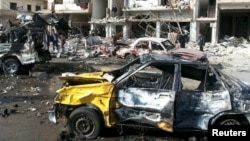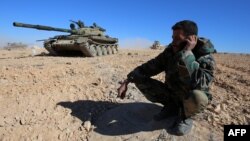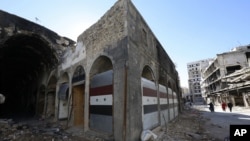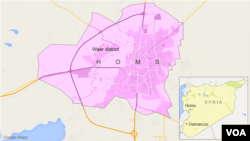Islamic State (IS) militants appear to have a growing influence in the central Syrian province of Homs and are likely facing a showdown with the Syrian regime, analysts say.
With the Syrian government firmly in control of the major urban area in the province – the war ravaged city of Homs – a major battle between IS and the Syrian regime could be looming, according to analysts. IS has claimed responsibility for twin blasts in the city that killed at least 46 people and injured dozens.
As the U.S.-Russian brokered cease-fire between government forces and opposition groups goes in effect this weekend, forces of President Bashar al-Assad can turn their focus to IS.
“The [Syrian] regime is the strongest party in Homs now,” said Hediye Levent, a Syria-based Turkish journalist who was recently in Homs. “The cease-fire would encourage government troops to go after Daesh [IS] in eastern Homs,” said Levent.
IS presence
The city of Homs has been almost entirely controlled by the Syrian government since May 2014.
However, the eastern part of the province is controlled by IS militants. From there, they launch attacks against government troops. IS areas of control include the ancient town of Palmyra that was taken from Assad forces in May of 2015.
“Daesh has a solid popular support in eastern Homs,” said Rami Abdulrahman, director of the Syrian Observatory for Human Rights. “This is why it can’t be easily uprooted from there.”
He said IS has presented itself as the only group that can protect regional Sunni Muslims in the face of the Syrian government.
“They [IS] targeted an Alawite-dominated neighborhood in Homs, for example, to show Sunnis that they can be relied upon,” he told VOA via phone, referring to the weekend bombings.
The Alawites, a subsect of Shi’ite Muslims, are considered the backbone of the Syrian regime in the country’s five-year-old civil war. They mainly live in the coastal region, but also have large presence in Homs.
Struggling to remain relevant
The presence of IS militants has noticeably increased in eastern Homs, according to reports. Local activists said this is partly because of the losses elsewhere in the country as a result of Western coalition’s and Russian air campaigns against them.
“Their control of towns like Mahin and al-Qaryatayn [in eastern Homs] has recently become tighter,” said Jassim al-Homsi, an activist from Homs who is based in Turkey.
He told VOA in a Facebook message that IS is incapable of entering the city of Homs. Therefore it is striving to remain relevant there by carrying out suicide attacks, he said.
“The Kurdish forces are advancing rapidly in eastern Aleppo and elsewhere,” Abdulrahman of the Syrian Observatory said of U.S.-backed Kurdish efforts against IS. “This might be the reason why Daesh is retreating to eastern Homs.”
Strategically important
Homs is strategically important for the Syrian regime as it connects Aleppo in the north to the capital, Damascus, in the south.
With the help of Russian airstrikes and militants of the Lebanese Hezbollah, government troops have maintained a grip on the city of Homs, expanding their operations into the northern part of the province.
Implementing the truce in Homs would be particularly challenging since local dynamics on frontlines change constantly, and this would affect the war on IS, analysts say.
“The major issue [in Homs] is that alliances shift so frequently,” said journalist Levent. “One rebel group could be with the Free Syrian Army, next day it could be with al-Nusra [Front] or Daesh.”

















